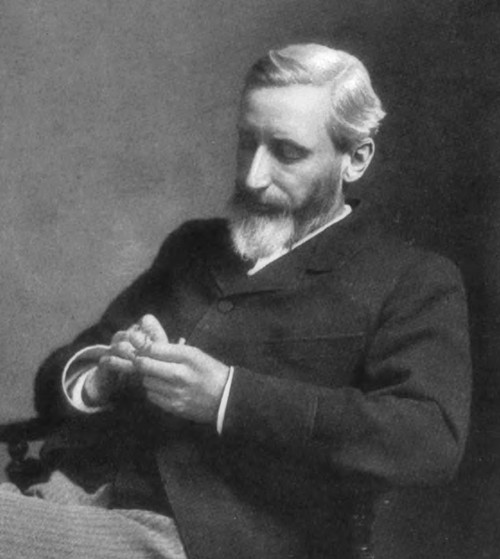“Curate” Is Radical — but How Radical?
I’ve done considerable reading for the Curated Crime Collection, focusing on “Sherlock Holmes era” fiction that makes a criminal the lead character. The earliest work in the Collection is Grant Allen’s “The Curate of Churnside,” published in 1884. Curiously, this tale remains the most startling among all I’ve read. First, Allen depicts a curate — an assistant minister in the Anglican Church — blatantly committing forgery, fraud, and finally murder.
Second, this character gets away with it!
Third, when I say the Reverend Mr. Walter Dene gets away with it, I don’t just mean he never gets apprehending by some nosy police official or by some prying private detective. I mean there’s absolutely no justice in the form of, say, the Hand of God, a Balancing of Karma, a Twist of Fate, or even so much as a Guilt-Ridden Conscience!
The boldness of this helps explain why, when the story was published in an 1884 issue of Cornhill Magazine, the finale appeared fundamentally revised — crime is punished there — in contrast to how it appears in Allen’s short story collection of the same year and another collection released in 1899. Presumably, the alternate ending in Cornhill ensured that outraged readers wouldn’t immediately cancel their subscriptions. Okay, I’m not sure magazine subscriptions were a thing at the time, but you see my point: “The Curate of Churnside” was risky stuff to publish in 1884 — and remained so for decades afterward.

Mixed Reviews
I was curious how Allen’s original readers reacted to this tale, especially the version found in Allen’s two collections, which we might assume was preferred by the author. Were they shocked? Or do I overestimate the late-Victorian demand that crime fiction end with some form of punishment for the villain? Based on critics’ mixed reactions, I suspect it depended very much on the reader.
Let’s start with a mostly negative review of “Curate,” as it appears in Allen’s Strange Stories (1884). At first, the critic for The British Quarterly Review concedes that the tale is “certainly cleverly managed.” Nonetheless, “the result can hardly be described as pleasant or inspiriting.” Adding a touch of clarification, this reviewer says that the story is one
verging perilously on the mere vulgar, sensational, penny-dreadful style, producing an almost grotesque effect which, if it were not for the horror, would be almost ludicrous.
Does this critic not consider how very consistently and predictably criminals are ultimately punished in the kind of stories suggested? Isn’t this part of the appeal: to leave with the feeling that Good eventually conquers Evil? That critic’s “horror,” I suspect, actually rises from Allen defying the conventions of “vulgar, sensational, penny-dreadful style” fiction and, in so doing, implying that murderers walk among us, unbothered by their crimes. As a critic from 1923 says: “There are, I fear, many such men in the world as Walter Deane [sic].” Evoking such an uncomfortable thought is, I think, the underlying power of “Curate.”
A more positive review is found in The Literary World, and it focuses on Twelve Tales (1899), the second of Allen’s collections to include the tale of the murderous minister. Here, it’s described as “perhaps, the strongest story Mr. Allen ever wrote” and its portrayal of Dene as “a masterpiece of characterisation.” Clearly, this reviewer spoke for readers who, like myself, see the story as something artistically great and historically significant.

On a side note, in their next issue, The Literary World mentions that a reader had pointed out the two very different endings: the one in Twelve Tales and the one in Cornhill. I find this very perturbing. You see, I wanted to be the first to publicly announce that Walter Dene — unlike that wanderer in the Robert Frost poem — managed to take both paths that diverged in a yellow wood!
A Sort of Spoof and Final Thoughts
My research led me to a goofy, not quite spoofy, short story titled “My First Murder,” written by Angelo J. Lewis, and published in an 1885 issue of Belgravia. (It was published again the following year in The Insurance Journal: A Monthly Review of Fire and Life Insurance, which is a bit funny, given the story’s topic.) Lewis opens by loudly referring to Allen’s tale, which his narrator finds in a copy of Cornhill while waiting at a dentist’s office. The character doesn’t have time to finish reading the story — and remember this version depicts Dene’s downfall — but he reads enough to be inspired to attempt a murder of his own. After a few near-misses, the narrator learns his intended victim’s situation has changed and there’s no longer a motive to commit the terrible deed. And they all lived happily ever after — I guess. Overall, it’s a pretty forgettable piece, but it reveals that “Curate” had made some kind of mark on the crime-fiction scene.
Another point of interest regarding how readers might’ve reacted is found in the story itself, at least, the version that Allen seemed to like. The author closes by addressing those in his audience who assume someone like Dene must be forever haunted by his dark deeds: these people are “trying to read their own emotional nature into the wholly dispassionate character of Walter Dene.” Significantly, after I summarized the story to a friend of mine, she insisted that, indeed, such an uncaught killer would surely be wracked by guilt. Maybe we’re not so very different from the Victorians. We long to believe that crime doesn’t pay, and this explains the enduring popularity of detective fiction.
All this makes me wonder how readers today will react to “The Curate of Churnside.” It’s available — with the Cornhill ending following Allen’s more controversial one — in The Curate of Churnside & The African Millionaire, the first volume in the Curated Crime Collection. More information is provided here.
–Tim


